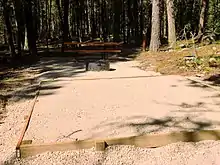Tent pad
A tent pad is a designated area at a campground site to a set up a tent.[1][2][3] It eliminates the need to find a suitable spot to pitch a tent.[2]

Often, a tent pad is a single row of timbers forming a square that retains the fill, resembling a sandbox.[1] In addition to wood, it can also be framed with cement or other material.[2] The framing allows the tent pad to be even and level on rough or sloping terrain and allows for more comfortable sleeping.[1] Some tent pads do not have framing, but instead are raised area of dirt that are sometimes topped with wood chips.[1] An open grassy area does not constitute a tent pad.[2]
Furthermore, a tent pad is often elevated about 4 to 6 inches.[2][1] This elevation also prevents standing water from developing and reduces the risk of flooding when it rains since it has better drainage.[1]
The tent pad also makes it easier to stake a tent since there are no large rocks or tree roots in the fill.[1] The fill can be composed of sandy soil, dirt, gravel, sand and gravel mix, mulch, cement, or river rock.[1][3]
Tent pads can come in a variety of sizes depending on the type of camping (e.g. backpacking, leisure camping) or region of the country.[1] There are no standard dimensions, but commons sizes include 8 feet x 8 feet, 10 feet x 10 feet, 12 feet x 12 feet, and 15 feet x 15 feet.[1] Some are oversized, greater than 15 square feet, designed to accommodate a large family tent.[1]
A campsite may have a designated tent pad, but otherwise a flat, durable surface like dirt or gravel would be a suitable alternative.[4][3] Having a designated tent pad can help prevent damage to the vegetation of the area from staking or setting up the tents in other areas of the campsite.[1][4]
Tent pads are most often found at developed campgrounds but can also be found in primitive and even wilderness campsites.[1]
Tent pads need to be maintained, otherwise erosion can occur and cause slopes and/or water channels to form.[1]
References
- "Tent Pads And Tent Camping - Campetent". Tent Camping at Campetent. Retrieved 2021-05-23.
- Dow, F.; Dow, S. (2009). U.S. National Forest Campground Guide, Pacific Northwest Region - Oregon. Moon Canyon Publishing, LLC. p. 497. ISBN 978-0-9767516-7-0. Retrieved 2021-05-23.
- "KOA Camping Blog". The Ultimate Guide to Camping Terminology: Camping Terms You Should Know. Retrieved 2021-05-23.
- Douglass, F.M. (2012). The Tent Camper's Handbook. iUniverse. p. 340. ISBN 978-1-4759-3509-7. Retrieved 2021-05-23.